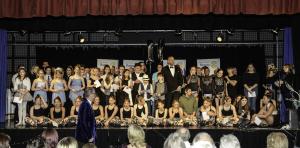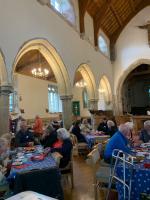Nottingham's Medieval Castle - Dave Young
Thu, Jul 27th 2023 at 7:00 pm - 9:00 pm
Brief history of this important local Castle where Dave has been a volunteer
Club members please log in for more information.
27th July 2023 The Forgotten Castle! – Dave Young
Dave’s interest in Nottingham Castle started at an early stage when taken there as a 4-year-old by his Mum & Dad, but it became more serious over the last 10 years when he has been a volunteer at the Castle. There’s a lot of history involved, but he started with information about the ‘Ducal Palace’, built in 1679 by the Duke of Newcastle, as his city residence. His family seat was at Welbeck and Clumber. But Dave’s real story is about the original Castle built in 1068 and lasting until 1651 when, following the Civil War, the Parliamentarians, now as a Republic, decided on a strategy of destroying a number of the Royal Castles. The Civil War lasting from 1642 to 1651 had the worst ever death toll in relation to population, concluding with the execution of the King Charles I. Oliver Cromwell, as the Parliamentarian’s leader did not want Nottingham Castle to be destroyed, but he was overruled and they continued After Cromwell died his son Richard took over but was unsuccessful and they invited Charles II, who had been exiled in France to return and operate under shared rule, with many of the nobles returning from their exile in support. One of which, The Duke of Newcastle on his return to Welbeck spotted the Castle site and decided to build his Ducal Palace there.
In 1831 a mob broke into the Palace and ransacked it then set fire to it. It burned for 3 days and nights causing the lead roof to cascade down blowing out the windows, leaving it as a total ruin. The duke applied for compensation, but the £21k offered he felt was an insult and said he would leave the building ugly and empty, which he did for 44 years. (Dave compared it to the current situation with the Broadmarsh Centre project!) Architect T C Hind remodelled the Palace and it was opened by the Prince of Wales Edward and his wife Princess Alexandra on 3rd July 1878 as an Art Gallery and Museum, the first outside London.
Back to the history of why the mediaeval castle is the best kept secret in English history, one of the 4 most important Royal Castles: Dover, Tower of London, Windsor and Nottingham, Nottingham was the principal Royal Castle in the Midlands for 500 years, on its 10.5-acre site it was 3.5 times the size of Old Market square, which incidentally is the 3rd largest provincial town square in the UK.
But WHY Nottingham?
1. The River Trent, 1 mile away, was the border between the North and South in those days, making it a Border Castle, (the Trent is the 3rd longest river in the UK after the Severn and the Thames, also unique in that I flows S to N.
2. Trent Bridge (originally built in 920) carried the principal N/S route from London to the North.
3. In the middle of England, it was perfectly placed for any campaigns against Scotland and Wales, as well as close to London.
4. Built on a 130ft high rock it proved impenetrable, it was never taken by storm in its life.
5. The favourite Royal Hunting ground of Sherwood Forest (covering 1/5th of the area of Nottinghamshire) was literally at the back door of the castle. Nottingham was a mighty military stronghold, the Monarchs kept their Armoury there, they made it a Royal Palace.
Dave then moved on to the monarchs, starting with William I (The Conqueror, originally known as William the Bastard) and there was reference to King Harold (slaughtered by 4 Norman knights, not an arrow in the eye as suggested by the Bayeux Tapestry, at the battle of Hastings. There was a ‘succession crisis’ when Edward the confessor died and Harold was quick off the mark and got himself crowned at the brand-new Westminster Abbey (just one year after being completed). Even the King of Norway was going to put his hat in the ring, until Harold defeated him in Yorkshire. In the 20 years following the conquest the Normans built about 500 castles (90 of which remain today). They forced the people of Nottingham to build the Castle, and William proceeded with a scorched earth policy and genocide in Northumbria. It’s thought that 75% of the population died up there. Moving forward 86 years, Henry II (1154 to 1189) rebuilt the wooden built castle in stone. Henry doesn’t get the appreciation he deserves in history, being flanked between the more memorable battle of Hastings and the Magna Carta.
Henry’s son, King Richard I, the Lionheart (who introduced the 3 lions on his shield representing England, Normandy and Aquitaine), after his activity in the Crusades returned to find his brother John had declared himself as King with his supporters having taken over Nottingham Castle. He besieged the castle I 1194, placing his very large catapult outside the castle capable of hurling 350lb of stone up to 350 yards. John’s men ran for their lives when they realised that it was King Richard himself outside the Castle. At this time John was away in France. When Richard died in 1199 John became king until 1216. In the year 1212 he was holding hostage 28 sons of Welsh Barons and following a threat by Llewellyn, he hung every one of them from the castle ramparts. He died October 1216 following a binge out on peaches and cider! (Dave referred to a similar reported incident with another king, Elvis Presley!) He was forced by the Barons to sign the Magna Carta the previous year.
Moving on again to Edward III, the son of Edward II & Isabella of France, he carried out a coup at Nottingham Castle, overthrowing Isabella and her lover Roger Mortimer. Isabella claimed that the young Edward was too young to take the role of King, so she took over as regent. Mortimer assumed the role of de facto king! When Young Edward reached 18 years old Edward III, with the help of his friend William Montague, carried out a daring raid on the Castle and captured Mortimer, dragged him down a tunnel, known today as Mortimer’s Hole, before taking him to London for execution. Edward III reigned for 50 years and never forgot his friends at Nottingham castle frequently returning to it right throughout his reign.
Then followed Queen Joan of Navarre (Henry IV’s wife), Edward IV, Richard III (Battle of Bosworth Field), Henry VIII (stayed at Nottingham Castle in 1511 and reinforced it in 1536 following an uprising against him), and finally Charles I who chose Nottingham as the Royal Castle to raise his standard and announce the commencement of the English Civil War.
Dave had more to tell us, but President David had to close things down, due to time constraints at the premises.
Doug gave the Vote of thanks for this very interesting and informative presentation, congratulating Dave on the lost history and Royal facts about Nottingham Castle, which he delivered with clear enthusiasm and humour. However, Doug suggested the real reason this important Royal Castle was sited in Nottingham was more to do with the Troglodyte community living in the caves which had the perfect ambient temperature of 10 degrees for brewing beer! As usual we had enjoyed the presentation and the members and numerous guests joined him in an enthusiastic round of applause. AR
'What We Do' Main Pages:

We have now successfully run this event for 10 years. Full reports of each year are available under this main page
moreIf you like what we do as an organisation and are interested in volunteering with us, keeping up to date with our plans and future events then why not consider signing up as a friend of our Rotary Club
more
This is a monthly meeting open to visitors from Bingham, Radcliffe, Cotgrave and all villages in surrounding area.
moreThis committee are involved in planning now we can raise funds for our chosen charities
more
It's here that you can read what we've been up to in the last few months. For more information on our work in the local community, with our young people and internationally please access "what we do" section of this web site.
moreOur International Committee is involved with Polio Plus - a Rotary initiative to eradicate Polio, World-wide; Sand dams; Aqua Boxes; Shelter Boxes; Collecting used spectacles, and many other projects
moreHere you can read about the many meetings we've had during our formation as a Rotary Club. The early years are a little short on detail...
more

.jpg)



